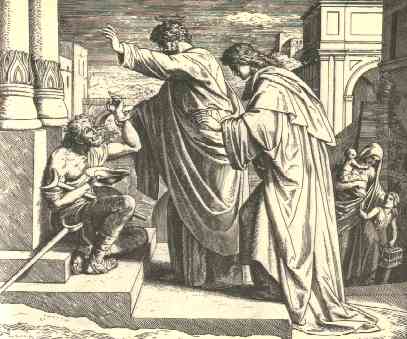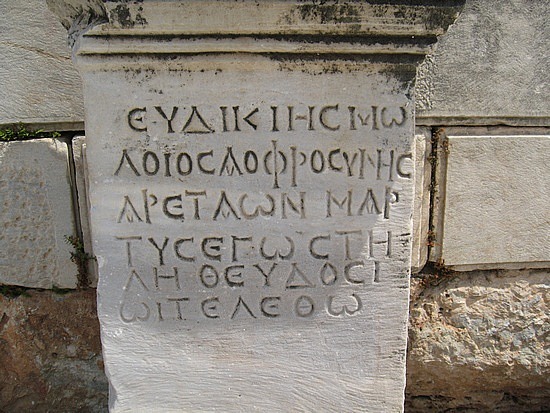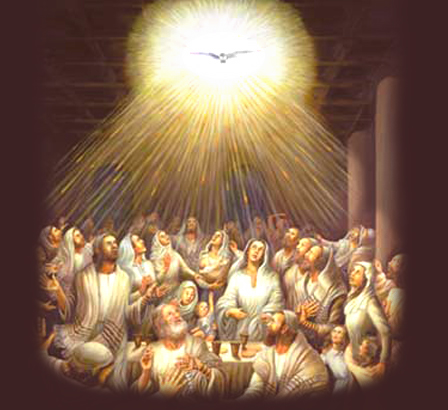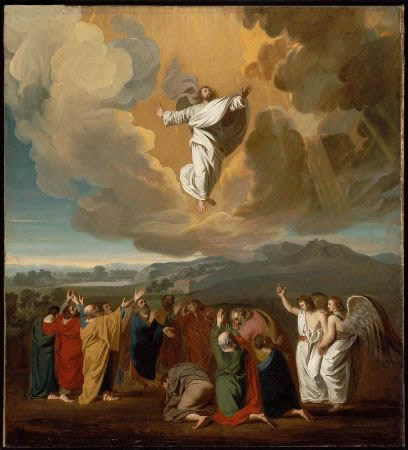Randy’s Bible Commentary Notes on Acts chapter one:
Chapter One Outline:
I. Witness in Jerusalem (Acts 1-7)
A. Introduction (1:1-3)
B. Ascension of Messiah (1:4-11)
C. Appointment of Matthias (1:12-26)
Summary [Chapter One]: This second letter written to Theophilus continues the story of the spread of the Gospel that he began in the Gospel According to St. Luke. This second epic opens with Jesus (after His Death and Resurrection) meeting His disciples and instructing them in Jerusalem. Jesus told them to gather and wait there until the coming of the Holy Spirit and then He ascended into Heaven. His disciples went back to Jerusalem and selected a replacement for Judas by casting lots. They narrowed the choices by character to two men: Joses (called Barnabas) and Matthias, who was eventually chosen.
Chapter One
1:1 “former treatise” no doubt refers to the Gospel According to Luke, based not only on this assertion, but also on the style and grammar of the two writings. It may be that these were two parts of an unfinished (or partially lost) trilogy, with the Gospel According to Luke the things done by Jesus the Messiah, and Acts showing the things done by the Risen Messiah through His Holy Spirit. An early reference to the Lukan authorship is found in the Anti-Marcionite Prologue to Luke (160 CE). For others, see notes on the Muratorian canon, or the works of the Apostolic, Apologetic and Later Church Fathers: Clement of Alexandria, Tertullian.
1:2 “Apostles”: (Greek: apostolos), means one who is sent forth or messenger. This was a person chosen and given a specific assignment with the full authority of the one who sent him. This was a common and abundantly used word. (Acts 2: 37, 42, 43; 4: 33,36; 5:12,18,29,34,40; Acts 6:6, 8:1,14; 9:27; 11:1; 14:4,14; 15:2,4,6,22,23,33, Acts 16:4, Romans 1:1, 11:13; 1 Corinthians 1:1; 9:1,2; 15: 9; Hebrews 3:1; 1 Peter 1:1; 2 Peter 1:1; Colossians 1:1; Matthew 10:2; Mark 6:30; Luke 6:13; 9:10; 11:49; 17:5; Romans 16:7; 1 Corinthians 4:9; 9:5; 12:28,29; 15:7,9; Ephesians 2:20; 3:5; 4:11; 1 Thessalonians 2:6; 2 Peter 3:2; Jude 17; Revelations 2:2; 18:20; 21:14)
The word Apostle specifically refers in Luke’s narrative to the initial 12 chosen disciple of Jesus. Most were with Him during the course of His ministry and they saw Him after His Resurrection. They were commissioned to be His witnesses to the far ends of the earth (Matthew 28:17). They are also together with the prophets recorded as the foundation of the household of God with Jesus Christ as the chief cornerstone.
The Twelve are thought by some to have been chosen as follows: Andrew and his brother Simon Peter, (Matthew 4:18-20), then James and John – the sons of Zebedee (Matthew 4:21,22), these four were fishermen. Then came Philip and Nathanael (also named Bartholomew – John 1:43-51). Then came Matthew, called Levi a tax collector (Matthew 4:9-13), Thomas, James the son of Alphaeus, Simon the Zealot or Cananaean, Judas, the brother of James and Judas Iscariot (Matthew 5:1-4).
Among them, the Disciples Peter, John and James were often taken aside by the Lord and would have been his inner circle. Peter was more the leader of the Twelve, while John has been widely accepted as “the Apostle whom Jesus had a special love for” (John 19:26). These three were present at the transfiguration (Mark 4:2), at the raising from the dead of Jairus’ daughter (Mark 5:37) and in the garden of Gethsemane during the last hour before Jesus was captured.
Judas Iscariot was the keeper of the moneybag (John 13:29) and was known to have betrayed Jesus for money (John 13:2). He hanged himself (Matthew 27:3-5). Thomas was known for wanting physical proof of Jesus’ resurrection for him to believe.
They were trained by Jesus, yet still were not able to grasp what his mission to earth was, believing that he was about to set up a kingdom and restore Israel(Acts1:6). Eleven of the twelve (not Judas Iscariot) were re-commissioned by the Lord Jesus, after His resurrection, to be His witnesses to the far ends of the earth (Luke 24:46-49) After the loss of Judas, Matthias was chosen by lots and took his place (Acts 1:23,26).
The apostles were regarded as ‘unlearned men’ by the priests, theTemplecaptain, and the Sadducees when Peter and John were brought before them because of preaching Jesus and His Resurrection (Acts 4:13). This probably means that they only had elementary rather than higher education.
The word apostle was also used to identify those who were not of the Twelve, but who had seen the risen Christ and were also commissioned by Him. Paul defended his Apostleship on the basis of having met with the Lord Jesus (on the way to Damascus) and on the basis of his highly effective ministry to the Gentiles (I Corinthians 15: 6-10).
James, the Lord’s brother was also counted an apostle. He was probably not a believer of Jesus before the crucifixion. The Lord Jesus appeared to him “After that, He was seen of James, then of all the apostles.” (1 Corinthians 15: 7). “…He was seen…then of all the apostles…” seems to refer to a wider group of people more than the Twelve apostles. I Corinthians 15: 5, indicates that Jesus was already seen by the Twelve.
It was agreed among the apostles that Paul and Barnabas were to concentrate on reaching the Gentiles while Peter, John and James (the Lord’s brother), were to continue their work among the Jews (Galatians 2:7-9). Paul also indicated that the apostles were exposed to much danger, and suffering, “For I think that God hath set forth us the apostles last, as it were appointed to death: for we are made a spectacle unto the world, and to angels, and to men…. Even unto the present hour, we both hunger, and thirst, are naked, and are buffeted and have no certain dwelling place.” (1 Corinthians 4: 9-13) Paul counts these hardships as taking part in the sufferings of Christ (Romans 8:17; 2 Corinthians 1:5-7). Most of the apostles are traditionally recorded to have been faithful and lived a persecuted life and apart from John, died gruesome deaths.
1:3 Of the “many proofs” note that Luke had previously recorded that the Disciples spoke with Jesus (Lk. 24:13-32), ate with Jesus (24:13ff) and could see His physical scars (24:39-40). Luke clearly stated a physical resurrection was part of the body of teaching of the early Christian movement.
1:3 “forty days”: This is the only reference to the length of Jesus’ ministry to the Disciples between the Resurrection and Ascension. Though obviously a serious recounting of the actual length of time, this may also allude to other important forty-day spans in the Bible. The time period is elsewhere a record of God’s great movements on the earth, i.e. in the time of the flood (Gen. 7:4;8:6); in the time God and Moses communed together on the Mountain of the Law (Ex. 24:18; Dt. 9:9); in the time Jesus suffered attacks of Satan in the Judean Wilderness (Mt. 4:2; Mk. 1:13; Lk. 4:2) . Others note the Biblical statement for the length of embalming a dead body (Gen. 50:3).
1:5 “Holy Spirit”: The work of the Holy Spirit was not unknown to the Disciples (cp. Jn. 14:17; 20:22) but the work was about to change. The promise of Jesus was that He would no longer be aiding from alongside the Disciples, but would be indwelling them in a way they had not experienced before. This is one step toward the work of the New Covenant (Jer. 31:31). The rest of the new agreement would not happen for a long time (and still has not yet happened!). A close look at the New Covenant promise in the Jeremiah 31 prophecy includes an abstract time line:
a) the days will come (future to Jeremiah – 31:27) when the landIsraelandJudahwill be desolate and broken (27,28);
b) in those days people will begin to take personal responsibility for the destruction (29,30);
c) the days will come (after that time) the Lord will offer a New Covenant (31) toIsrael. (It will be a different kind of covenant than Sinai (32).
d) Some time AFTER the offer (31:33) God would begin to “write the Law on the hearts” of the people ofIsrael.
e) The nation will be drawn back to God (34) and all will be saved! (34)
f) God promised that the relationship withIsraelwould be fulfilled and not set aside EVER (35,36).
The move of the Holy Spirit to inside the Disciples was equivalent to the “Word” dwelling in them richly (note the same results from the “work of the Spirit” in Ephesians 5 to the “work of the Word of Christ” within in Colossians 3). The believer was called to operate in the power of the Holy Spirit, which was the same as operating in the Word of Christ. The work of the Spirit performs the promises of Messiah in the guidelines given in the Scriptures.
The brief time that Jesus shared the “breath” of the Spirit with the Disciples (Jn. 14:17) was perhaps the one time they could use to distinguish the experience in the new work the Spirit was doing in them. Had Jesus not done this, they may have been unable to distinguish the nature and source of the work in Acts. The Disciples were prepared by Jesus, however, and knew the work was from above, the beginning of the New Covenant promise that would not be completed in one instant (cp. Acts 2:16-21). Note that Peter realized the work would culminate in the salvation ofIsrael, but not that day!
1:11 “in like manner”: the return of Messiah should therefore be public, to theMount of Olives and miraculous. For later Apostolic material on the return of Jesus, cp. Rev. 1:8 and 19:11-16.
w1:12 “Sabbath”: (see also Acts 1:12; 13:14,27,42,44; 15:21; 16:13; 17:2; 18:4; Colossians 2:16; Genesis 2:1-3; Exodus 20:8-11; Leviticus 23:3; 26:2). Sabbath (Hebrew: shabbat) is literally translated “rest” or “cessation of normal activities”. The origin of the Biblical Sabbath is found in Genesis 2:1-3.
Observance of the Sabbath day is first mentioned in the book of Exodus 16:23, when the children ofIsraelwere in the desert. It became a symbol of the Covenant relationship between the children ofIsraeland the God of Abraham given to Moses onMount Sinai(Exodus 20:8-11).
Though part of the observance of the Sabbath a day was rest and refreshment before God, it also a day of holy assembly or worship unto Him (Leviticus 23:3). In addition, it served as a constant reminder of God’s continued covenant withIsrael(Ezekiel 20:12), and was later applied as a reminder to them that God had delivered them from Egyptian slavery. The Israelites were expected to keep it with such seriousness that Sabbath breakers were to be stoned to death. No fire was kindled and no sticks were gathered (labor associated with other days of the week).
The prophets considered proper observance of the Sabbath day as a litmus test of obedience to God. They argued that it directly affected the success and standing of the people ofIsraelandJerusalem, or their downfall and decay of the city ofJerusalem. In that way they considered the Sabbath observance as a thermometer for the spiritual condition of the Israelites (Jeremiah 17: 19-27; Nehemiah 13: 15-22, Isaiah 58:13, Ezekiel 20:12,24, 22:8).
The term Sabbath was not only used for the 7th day of the week and also for special observance days, feasts and periodic observance years. The Day of Atonement was referred to as a Sabbath (Leviticus 23:32), Feast of Unleavened Bread (Leviticus 23:7,8), and the seventh year in the growing cycle (Sabbatical year). These were prescribed for the Hebrews and included foreigners who dwelt among the Israelites, called those who “drew near to cleave to the God of Israel”.
The Sabbath year of rest for the land was observed after six years, Leviticus 25:4, “But in the seventh year shall be a Sabbath for the LORD: thou shalt neither sow thy field, nor prune thy vineyard.”
The Year of Jubilee was calculated by the Sabbath years, Leviticus 25: 8, 10 “ And thou shalt number seven Sabbaths of years unto thee, seven times seven years; and the space of the seven Sabbaths of years shall be unto thee forty and nine years.” ”And you shall hallow the fiftieth year, and proclaim liberty throughout all the land unto all the inhabitants thereof: it shall be a jubilee unto you; and ye shall return every man unto his possession, and ye shall return every man unto his family.”
In the wrestling of the early Rabbinic courts of the Sanhedrin over how best to keep the Sabbath rest the commands were developed and systemized such that by the time of Jesus, proper observance of the Sabbath restricted many acts not specified by the Torah. Some prohibited extensions of mercy, causing great controversy and contention among the religious leadership in the Gospel accounts of the ministry of Jesus. An example of this was a case of the Pharisees expressing great problem with the healing ministry of Jesus on the Sabbath. Another example is found in the account where Jesus allowed His disciples to pick grain to satisfy hunger on a Sabbath.
The Gospel accounts share that Jesus argued against this particular Rabbinic standard by expressing the purpose of the Sabbath, and the priority of the people. He replied to the argument: (cp. Mk. 2:23-28) “The Sabbath was made for man, and not man for the Sabbath: so that the Son of man is lord even of the Sabbath.” To the question of showing mercy in healing, (Matthew 12:10,12) Jesus replied, “Wherefore it is lawful to do well on the Sabbath days.” Other references include Matthew 13:1-14; Luke 6:1-11, John 5:1-18. It appears that Mishnaic rabbis (after this time) agreed with Jesus’ interpretation of the mercy on Sabbath approach (as certainly some did during His lifetime) and their teaching included the ability to show mercy and to heal on Sabbath in later periods.
In the earliest movement of the church in Acts most followers of Jesus were Jews who kept the Sabbath. As the message of the Gospel progressed into the Greco-Roman world under the ministry of Paul, Barnabas, Silas, Timothy and many others the meetings were both on Sabbath and on other days, “daily and houses to house”. For these Messianic Jews, the Sabbath continued to be a symbol of God’s everlasting covenant throughout the Book of Acts. For Gentile believers in Jesus, it was a question of choice (Col. 2:16). When Jewish believers attempted to enforce such practices on the Gentile believers, Paul withstood them on the basis of misappropriation of the covenant symbols. For more on the day of the week for the meeting of the early believers, see comments on Acts 20:7.
1:12 “Sabbath day’s journey”: a distance of about half a mile, which is the distance allowed for travel on the Sabbath day, according to rabbinic tradition. Though the Bible did not express such a specific distance, any person travelling in excess of 2000 cubits (3000 feet) was accused of breaking the fourth commandment statement: (Ex 16:29) “…let no man go out of his place on the seventh day”. The size of the “place” was based on Numbers 35:5 which measures out the “suburbs” of the cities in cubits: 2000 cubits to the east, 2000 cubits to the south, 2000 cubits to the west and 2000 cubits to the north side of the city. These suburbs may have been the pasturelands around the cities on which inhabitants of the cities planted their crops and put their flocks to grazing. At various excavation sites of ancientIsrael, archaeologists have identified the stones placed at the outer extremities of these suburbs at what may have been the lawful limits of a Sabbath day’s journey.
Acts 1:13 “Upper room”: The Greek term for this room is huper-o’-on, a different term than the kataluma of John 13-17. The term used in John reflects a different location, and was used only there and in association with the term “inn” (where there was no room for Jesus’ birth – Lk. 2). The term in John is loosely translated “furnished guest chamber”. In a setting like this one (a place used for banqueting) one could expect the place to have been a triclinium (three sided reclining table).
Apparently the place was large (Acts 1:13) and had adjacent living quarters, as the disciples may have stayed there for some period. Banquet rooms (triclinia) were normally a main floor feature of a private villa of wealthy Romans of the period. Numerous examples have been uncovered, including four contemporary examples in the Jewish Quarter of Jerusalem. Scholars suggest the home may have been that of Mark’s mother, who (according to Acts 12:12) was the owner of the home where many people were praying in the early believing community.
According to early Christian writers, an “upper room” was still intact a century after the crucifixion of Jesus, yet it is difficult to know if the room was that of the Last Supper, or of the events in Acts 1. The “upper room” visited by Christian pilgrims inJerusalemtoday recalls the room of the Last Supper. It is located in the same building as the Tomb of David (on the floor directly above) and is a barrel-vault Gothic style building of the 1300s. This room features a Moslem prayer niche (from when it was changed to a mosque, along with beautiful windows that have been recently restored. Often pilgrims confuse the setting of the two events (the Last Supper and Pentecost), which have only been celebrated in the same location in the last 500 years. A careful look at the venue for the Last Supper demands a private place, whereas the setting for the coming of the Spirit at Pentecost appears to be a public setting.
1:15 “stood up”: What a remarkable transformation in Peter! He had denied Jesus three times (Jn. 18). He was conspicuously quiet at the appearances of Jesus in the Upper Room (Jn. 20:26ff). Two events gave Peter a holy boldness: 1. The public acceptance of Jesus (in front of the other Disciples) by the shore of the Sea after the denials (Jn. 21); and 2. The indwelling of the Holy Spirit (Acts 2:1ff).
1:26 “lots”: This sounds like gambling, but actually has a solid Biblical precedent (compare Prov. 16:33; Jonah 1:7). The scapegoat was chosen in this way (Lev. 16:8ff). The Bible record does not condemn the method of choice here or elsewhere. Remember, the Book of Acts is a narrative, not an instruction. The point is NOT to get this methodology for church decision-making, it is a simple record of what they did. Some Scriptures are simple narratives (like Gideon and his fleece – cp. Judges 6-8). In such cases, one can appreciate the story without feeling the need to imitate it.







